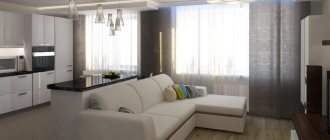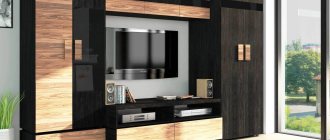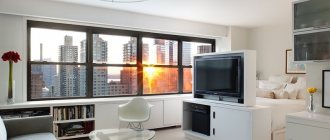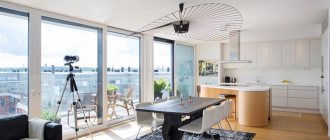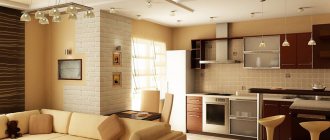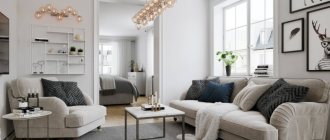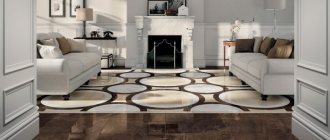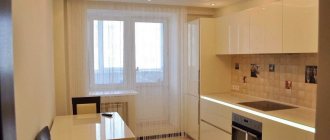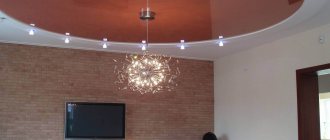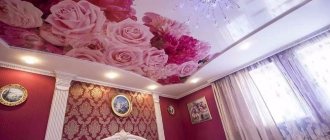When modern apartments are renovated, two rooms are often combined to expand the space. Among other questions, a dilemma arises about how to decorate the ceiling in the kitchen-living room in order to emphasize the features of the room and not overdo it. It all depends on the goal, budget and interior design.
The ceiling covering in the kitchen-living room should look attractive, be practical and durable
Ceiling design options in the kitchen-living room (photo selection)
If the owners decide to combine two different spaces, then they need to decide whether they will be one whole or should complement each other. This is fundamentally important, since with this decision we begin to think through the concept - one or two stylistics.
The design of the ceiling carries an important emotional load in the interior of the kitchen-living room
In the context of the design of the entire room, the design of the ceiling is also thought out, and the following factors should be taken into account:
- Dimensions. If the room is low and has a small area, then you should not choose a two-level option for finishing the upper surface; it hides excess space. It is not recommended to choose too dark tones. And in very spacious rooms you can use stucco to emphasize and create a somewhat pretentious atmosphere.
For a small room, suspended structures are contraindicated, but a ceiling with an illuminated niche will create the illusion of a high ceiling - Lighting. The kitchen area needs more light and preferably with LED lamps. The living area usually requires more comfort and dim lighting; solutions of variability are usually adopted.
- Invoices. Various materials on the ceiling in the kitchen-living room in interior design often look impressive and speak of an individual approach to design.
Polystyrene panels are a budget-friendly and very effective way to create a variety of textures on the ceiling surface
The style of one part of the room cannot be radically different; they must be consistent, even if the contrast method is used.
Plasterboard structures
Combining a living room and kitchen with high ceilings, most designers install multi-level plasterboard structures. From a design point of view, this solution is universal, although it requires quite a lot of time to implement: for this option you need to build a complex frame and finish it with plasterboard sheets.
This method is not used to create a single, even ceiling. But zoning of varying degrees is performed masterfully.
- Two-level - in the simplest case, a figure of the second level is formed above the kitchen area, and a figure of the first level is formed above the living room, since it has a large area. A more complex option involves creating several second-level figures, for example, a wide rectangular beam with built-in lamps that separates the kitchen from the living room, and second-level figures around the perimeter of each zone.
In the techno style, a combination of geometrically correct second-level figures or niches with the same clear outlines simultaneously emphasizes a single space and structures it to the proper extent. In this way, you can create smaller zones - above an armchair and a work table, for example, above a bar counter.
The configuration is possible and as curvilinear as desired: plasterboard is flexible and allows you to create the most complex shapes. This option is more suitable for various classical styles, as well as high-tech and fusion styles.
- If the height of the room allows, multi-level ceilings are installed - with three or even more height differences. This design can be extremely decorative and complex. It is the ability to form any volume with any configuration from plasterboard that makes it a favorite material for designers.
In addition, drywall can be painted, whitewashed, wallpapered, tiled, and even hand-painted.
Modern ceiling design
Often, architects deliberately create a layout with a combined kitchen to increase demand. This is a fashionable trend; many owners appreciate the advantages of this option. But figuring out how to make a ceiling is a task that people with innate good taste and professional designers can do. After all, more than one question is posed here:
- make the ceilings in the living room combined with the kitchen competently by modern standards;
- choose a single style or two;
- whether to divide the surface by structure, color.
One of the goals of modern ceiling design is to create comfort. If the owner feels good in such an atmosphere, the eye does not “stumble” on anything, this is one of the indicators of a successful project.
When choosing a design, it is not at all necessary to strictly follow one style direction. It’s better to take a couple of your favorites and select from them what you like
Volumetric details
You can visually separate the food preparation area from the guest part of the room by creating a three-dimensional figure on the ceiling. It can be made of gypsum sheet, made using stretched fabric or assembled from panels. A three-dimensional figure is created at the border of two zones and visually separates parts of the room from each other.
In terms of installation complexity, they can be classified as the simplest to perform. Even the least experienced craftsman can assemble such a part from plasterboard in a few hours. Some more time will be needed for finishing, which consists of puttying the surface of the part and then painting it or finishing it in other ways.
If you create such a divider using tension coverings, then you won’t have to do anything yourself - everything will be handled by a team of installers who install suspended ceilings. At the same time, you will have the opportunity to choose the color, type and texture of the material.
If you assemble a similar part from panels, then the principle of construction will be the same as when working with gypsum plasterboard. You will need to assemble a frame on which the covering fragments will be attached. The panels can be easily processed with a sharp knife or metal saw, so there will be no problems with installing the composition. Assembling such an element will only take a couple of hours.
Options for finishing ceilings in the kitchen-living room
With ceilings in the living room combined with the kitchen (see photo), it is important not to make a mistake, otherwise the miscalculation will be double the size. Careful selection of materials is important so that the finishing emphasizes the advantages and decorates the room.
Textured wallpaper will hide minor defects in the ceiling covering
Tensioners
Stretch ceilings are a popular option with many variations of colors, shapes and structures. It is installed either as a single canvas over the entire space, or they try to combine it with drywall or other variations. Sometimes two different tension panels are used, harmoniously combined, but selected for a specific zone in space.
The stretch fabric can be matte or glossy, plain or patterned
From plasterboard
Beautiful lines are often created from this material and spot lighting is used to enhance the effect. This applies to the two-level option, but one layer is also used, especially if the surface of the original ceiling turned out to be problematic. Only in the case of very low walls should you carefully select such a finish.
You can make anything from plasterboard, in accordance with the design ideas of the owners of the kitchen-living room
Combination of plasterboard with suspended ceiling
This combination is especially popular among owners who want to make their kitchen-living room special and memorable. This ceiling option looks impressive when it creates the illusion of a floating element in the middle of the ceiling. You can use canvas with or without gloss, any pattern or structure.
Stylish combination of white plasterboard structures with mirror inserts made of stretched fabric
From other materials
Lovers of a loft or farm theme will like wooden coverings. It can be a ceiling design in the kitchen-living room as a decor on a putty surface or completely made of boards. Also, sometimes this surface is covered with wallpaper in the same color as the walls or another color.
Natural wood or its imitation is perfect for decorating the ceiling of a kitchen-living room in a modern style
Painting as an option for finishing the ceiling
One of the budget options is painting; it looks good if the surface itself is perfectly flat. Then you can choose an interesting shade and come up with a painting. Sometimes the ceiling is painted snow-white, and around the place where the chandelier should be, an image is drawn with thin gold lines and other techniques.
Painted ceilings are easy to clean from dust, but stains can only be removed by repainting.
We combine a cooking area and a place to relax:
Pros and cons of merger
Layout features
- Kitchen-dining room
- Dining room-living room
- Kitchen-dining-living room
How to properly zone
Traditionally, long family dinners are held in the dining area, where guests are greeted and feasts are held. But, alas, few people can allocate an entire room for it. And is this necessary? Agree, it is much more convenient when the work area is nearby. That’s why their unification seems so logical. What should you pay attention to when developing the design of a kitchen, dining room and living room in a private home and beyond?
- Living room
Design of a kitchen-living room with an area of 15 sq.m (53 photos)
Types of ceilings for the kitchen-living room
To combine, but leave the individuality of each zone, you can make everything out of plasterboard, but there will be one level on one side and two on the other.
- Single-level. A single-level ceiling allows you to avoid unnecessary issues with problematic original ceilings. It is easy to install, quite durable and looks neat. Plus, it is not difficult to fix if damage occurs.
A single-color ceiling on one level leaves the kitchen-living room space as it really is - Multi-level. They give you the opportunity to “play” with lines, color and lighting. But there is one disadvantage, noticeable only in some cases, they reduce the height of the walls. But in most cases, such installation is a way to make your room stylish, thoughtful and comfortable.
By placing surfaces at different levels, you can achieve the effect of expanding the space and increasing the height of the ceiling
Legal subtleties
If you have a gas stove installed in your kitchen in an apartment building, combining the two rooms is prohibited by law: you cannot demolish the walls. There is one possibility: make the doorway wider. In this case, the kitchen and living room will be adjacent. The doorway can be designed in the form of an arch or made square - it depends on the interior. In this case, doors are required in the opening. They can be sliding or folding, but they should be.
The partition between the kitchen and living room cannot be removed, but the doorway can be expanded
If electrical equipment is standing, merging is possible, but a wall can only be demolished if it is not load-bearing. Supporting walls cannot be dismantled: the entire building may collapse. But there is a way out: instead of walls, install columns equal in bearing capacity to the former wall. To do this, you need to order a remodeling project from a specialized organization.
You cannot remove the load-bearing wall, but you can replace it with columns that will have the same load-bearing capacity
Just make sure in advance that such alterations can be accepted by the administration and that you will be given permission for such work. It is necessary to obtain it in any case. To do this, you will have to write an application and attach a redevelopment project.
After receiving permission in hand, you can begin to demolish the partition.
How to zone a space using ceilings in the kitchen-living room: interesting ideas (selection of photos)
A suspended ceiling is often used for precisely this purpose; it can play a role in zoning. Considering that many owners prefer a two-level ceiling, this can be done with the help of lighting, creating the effect of a floating element in the middle.
With the help of spectacular lighting of the ceiling structure, you can highlight the dining area of the kitchen-living room
Also, zoning using the ceiling is performed:
- using different textures;
- creating different levels - two or more;
- They use more than one material, etc.
The bright red color of the plasterboard structure acts both as an accent and as a space divider
Combining 2 or more finishes can have a positive effect on the overall interior, but it is important not to overdo it with colors.
Choice of colors
The optimal color scheme will transform the interior of the kitchen and living room. At the same time, consider the purpose of each zone. So, the living area and kitchen should not contrast with each other (see the photo below for a good example). For a combined room, this is extremely important, since there may be a feeling of disconnection between zones. But if you take this requirement into account, you will get a harmonious interior.
Original color scheme
It is recommended to decorate walls, ceilings and curtains in pastel colors. Large spaces look better when they are neutral. But the small components of the interior are made bright. Keep in mind that each color produces its own effect. So, the orange color of the walls will narrow the room, and white tones will do the opposite. If you understand the color schemes, you can create a truly luxurious interior of a kitchen combined with a living room.
Pros and cons of suspended ceilings
The advantages of suspended ceilings quantitatively outweigh the disadvantages; they include the following:
- Long term.
- They are safe and environmentally friendly.
- Saves from dampness.
- They have average prices.
- It is easy to care for.
- Big choice.
- They hide engineering structures if they run along the ceiling.
The main advantage of a stretch ceiling is its resistance to leaks and humidity fluctuations
At the same time, there are disadvantages to this option:
- Although it can be quickly installed, it is difficult to do on your own.
- The seams, especially if not done by a professional, may be too noticeable.
- The smell lasts for several days, then becomes less noticeable and disappears completely.
The tension fabric is quite easy to damage with a sharp object.
If there are allergy sufferers in the house, you will also have to carefully study the composition of the material used for suspended ceilings.
Painting
It is not always possible to create a suspended structure on the ceiling. In this case, the ceilings are simply leveled and painted. The surface is smooth and located in the same plane in the kitchen corner and living room. To create a zoning element in this case, you just need paint of several shades or colors and masking tape.
The latter is needed in order to make the edges of areas painted in different colors smooth. Use any paints that are suitable for your room, taking into account the fact that the kitchen will need to be cleaned more often. It is advisable to choose washable or other wear-resistant dyes. The shade is chosen according to your wishes, taking into account compatibility with the overall design.
Color for decorating the ceiling in the kitchen-living room
The most common colors for ceilings are shades of white, followed by pastel options. Combinations with dark and black colors are considered a special style. But many owners decide to make bright decisions as an accent or addition to the interior.
A white ceiling is always relevant for small rooms
It should be remembered that each shade has its own effect on the psyche and mood of a person. Creating a specific and special atmosphere is the task of the designers. Choosing a boring palette can cause depression, and intrusive colors in large quantities can irritate and affect feelings of anxiety.
Sky blue panels combined with white beams create a pleasant nautical ambience
Too many dark solutions without proper lighting often become a bad option. And illiterately selected light shades carry a feeling of dullness and emptiness. Therefore, it is important to take into account the overall appearance of the room when determining the color of the ceiling.
What kind of ceiling
First you need to decide how the ceiling itself affects the lighting of the room. Obviously, white matte film and black glossy film behave differently, so it’s worth thinking about this issue more seriously.
Type of tension fabric
Stretch ceilings made of PVC film can be:
- matte;
- glossy;
- with metallic effect.
There are also fabric stretch fabrics with a satin effect, but they are not suitable for use in the kitchen because they absorb odors and grease and will not protect the neighbors above from leaking pipes.
Therefore, if you make a suspended ceiling in the kitchen, then only from PVC film. The matte canvas looks like a regular whitewashed ceiling, creates virtually no glare, making the room a little more spacious. Light is reflected weakly, so it is better to choose chandeliers whose shades are open at the bottom. For example, three lamps facing down will provide more illumination than six lamps facing a matte ceiling.
The gloss almost mirrors what is underneath, so it is advisable to choose those chandeliers where the shades look down again. It is unlikely that anyone will like to study the structure of a chandelier while looking at the ceiling. This canvas maximizes the space and raises the ceiling. Spotlights, ribbons, and original chandeliers look impressive. The main thing is not to direct the light directly.
A ceiling with a metallic effect is the rarest option among those listed, because it is quite difficult to fit into the interior. It dims the light a little and makes it soft.
Color
Don't forget that the color of the ceiling also affects the lighting. For example, if a cold white color is chosen, then adding the same cold lamps will create an uncomfortable atmosphere in the kitchen.
Dark colors actively absorb light, so there should be more sources. This need creates another interesting effect - a starry sky, only instead of stars there are lamps.
Ceiling height
If the ceilings are very high - over 3 meters, then ordinary spotlights cannot be used, since their light will not be enough. In this case, you don’t even need chandeliers, but pendants with a long cord.
The length of the cord can be adjusted and left at the desired height, for example, lower over the kitchen island and dining area or higher in the center of the room.
If the ceilings are low, then the suspension, on the contrary, will not work, since the height of the walls will be very noticeable. In this case, you should prefer ceiling chandeliers and spotlights.
Square
If in a small kitchen you can get by with one lamp in the center of the room, then in a large room this will not work. There are three areas in the kitchen that need to be illuminated:
- working;
- lunch;
- central (main).
Even in a small kitchen, one central chandelier may not be enough, because when a person stands near the work area, he creates a shadow and, as a result, works in an unlit place. For this reason, the countertop lighting is often placed along the bottom of the upper cabinets - there you can attach an LED strip.
In a large kitchen, for example, combined with a living room, several lighting sources are even more necessary for a comfortable stay.
If the dining table is located against the wall, then it is not necessary to lower the pendant from the ceiling to it; you can attach the sconce to the wall. The original lighting method for a spacious kitchen is a spot system. It can be chosen in any shape and run through the entire kitchen from the work area to the dining area. Additionally, in such cases, a diode strip is attached around the perimeter of the room.
Ceiling lighting design in the kitchen-living room (photo selection)
The combination of two rooms leads to the desire to divide them into thematic spaces. This can also be done with ceiling lighting. For example, installing spot lighting elements around the perimeter will definitely fulfill its function. Shades of emanating light in one and the other part of the room can also help.
A pendant lamp above the table or in the center of the room provides general lighting for the kitchen-living room
Spotlights are used to illuminate functional areas in accordance with a pre-designed scheme
So, the ceiling in the kitchen-living room is an important part of the interior, capable of transforming the space or ruining it if lines, materials, and colors are used incorrectly. Before you settle on a specific choice, you should take into account all the nuances so as not to pay twice later.
Color
The dimensions of the room and its side will help you decide what the ceiling will be like. A kitchen-living room with windows facing south will look advantageous with a cold-colored ceiling. Blue, blue, purple or green will make the room cooler and visually raise the ceiling. On a hot, sunny day it is especially pleasant to be in such a room.
The purple ceiling enlivens the room and gives a good mood Source stroy-podskazka.ru
Warm colors are suitable for a kitchen-living room with a northern location: yellow, orange, pink, red. Warm shades will add warmth and comfort to the room. Soft, sunlight will dissipate, creating a romantic atmosphere. You will want to spend more time in such a room. The kitchen-living room will become your favorite room in the house. Warm colors work best in a room with high ceilings. Rich, warm shades slightly reduce the height of the room.
In small rooms, it is advisable to choose a light color for the ceiling surface. Dark - will decorate a large apartment. Black, gray, brown will add style, uniqueness and rigor to the room. Dark ceilings require good lighting. If there is little light in the room, the ceiling will look gloomy.
A black ceiling in the kitchen requires much more lamps than a snow-white guest area Source design-homes.ru
The color of the ceiling should be combined with the overall scheme of the room and interior items. You can choose a shade close to the tone of the walls, furniture, and textiles. If the room is bright, it is better to choose a solid, pastel shade. A light ceiling will soften bright colors and add harmony to the room. White, beige, pearl gray are universal shades that will suit any room.
The ceiling in the living room kitchen, decorated in several colors, divides the room into zones. In the kitchen, a shade close to the façade of the furniture will suit; in the guest area, a color similar to the upholstery of the sofa. You can use two similar tones, close in saturation and brightness. One color of the ceiling in two zones will make the room a single whole.
The cool shade highlights the kitchen, the light tone of the living room ceiling adds coziness Source design-homes.ru
If you want to make a bright ceiling, you can use a combination of two colors: a calm, pastel shade and any rich one. The design is suitable for multi-level plasterboard structures, stretch ceilings with photo printing, and artistic painting. The combination of more than 3 bright colors on the ceiling looks provocative. A ceiling that is too contrasting will put pressure on the psyche and make the room aggressive.
The combination of white, beige, and walnut looks good in a classic kitchen-living room Source akuhnja.com
Photos of ceilings in kitchens and living rooms
Types of paintings
There are several common types of coating for canvas:
- Glossy. Such a surface will reflect light, making the entire room seem much more spacious and brighter. Glossy ceilings are suitable for small, cramped kitchens in small apartments, especially if you choose a beige or milky white shade. To care for them, you will need a microfiber cloth and glass cleaner.
- Matte. Does not reflect light, looks like a traditional ceiling with putty, on which the seams remaining from installation are invisible. This coating fits well into a room decorated in a classic style. Great for creating a single-level ceiling in the kitchen.
- Satin. It can be called the golden mean between matte and glossy finishes; it has a characteristic unobtrusive shine. Reflects light sufficiently to visually expand the room slightly. The satin finish is easy to maintain and the surface is much easier to clean from soot and dust.
Vinyl stretch ceilings are less common. They can hold back large amounts of water, which can save the interior from flooding if the upstairs neighbors have problems. However, vinyl is the least resistant to mechanical damage; the canvas requires more careful handling not only during operation, but even during the installation process.
[custom_ads_shortcode3]
